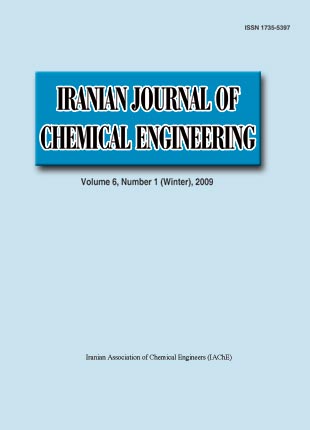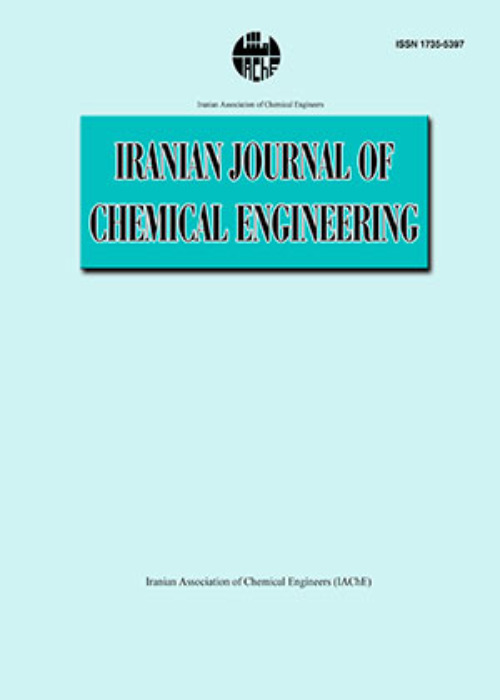فهرست مطالب

Iranian journal of chemical engineering
Volume:6 Issue: 1, Winter 2009
- تاریخ انتشار: 1387/12/20
- تعداد عناوین: 7
-
-
Pages 3-11Synthesis of Dimethyl ether from methanol was investigated over H-ZSM-5 and promoted H-ZSM-5 catalysts employing Mg, Na, Zr, Al and Zn components. All samples were characterized by AAS, BET, XRD and TPD analyses. Results of TPD analysis indicated that the number of weak strength acid sites increased on the surface of Na, Zn and Mg modified H-ZSM-5, while the number of medium strength acid sites increased on the surface of Zr and Al modified H-ZSM-5. Zr- modified H-ZSM-5 zeolite exhibited higher activity (94%) and selectivity (99%) than other materials while all modified catalysts exhibited good stability.
Ultimately, it was concluded that production of dimethyl ether from methanol occurred on acidic sites with medium and/or weak strengths. In this direction, an optimum catalyst for dehydration of methanol to DME with high conversion, selectivity and stability was developed.Keywords: Dehydration, methanol, dimethyl ether, H, ZSM, 5 -
Pages 12-22The effectiveness of binary mixtures of phosphorus and sulfur compounds as coke inhibitors for naphtha pyrolysis has been studied. As both phosphorus and sulfur compounds proved to be promising coke inhibitors, runs were made with mixtures of these compounds. The coke deposited was significantly lower when phosphor was used together with sulfur. Also, the effect of the addition of Na2CO3 and K2CO3 in the naphtha feed was investigated. It was found that the addition of Na2CO3 and K2CO3 reduced the coke formation. Scanning electron microscope (SEM) was used for the microstructure of deposited coke and energy dispersive X-Ray spectroscopy (EDAX) for the surface elemental composition of coke formed on the surface of stainless steel coupons. It was found that in the presence of inhibitors, deposited coke has a porous structure and so small amounts of Ni , Cr , and Fe elements.Keywords: Coke deposition, Coke inhibitor, Organosulfur compounds, Organo, phosphor compounds
-
Pages 23-39A mathematical model is developed for describing the dynamic behavior of the gas phase ethylene polymerization reactor. The model is based on the dynamic two-phase concept of fluidization in which the bubbles may contain solid particles and the emulsion is capable of containing more gas than that of minimum fluidization. The fluidized bed reactor is divided into several serial sections consisting of bubble and emulsion phases. Flow of the gas is considered as plug flow through the bubbles and perfectly mixed through the emulsion phase. Polymerization reactions occur in both emulsion and bubble phases. Variation of the process variables as well as the polymer properties were studied as a function of operating time. The bed height was controlled by the product withdrawal rate with a PID controller. The results of the model were compared with the experimental data and a good agreement was observed between the model prediction and actual data. The simulation results indicate that a significant amount of polymer production (roughly 12%) takes place in the bubbles.Keywords: Fluidization, Polyethylene, Dynamic simulation, Gas, phase polymerization
-
Pages 40-49This research work is concerned with the bioconversion of a heavy hydrocarbon cut from a petroleum refinery using native anaerobic consortia. The heavy cut is taken from one of the end-cuts of the vacuum distillation column of Tehran refinery which is normally fed into Isomax unit (a catalytic cracking process) called Isofeed. The consortia for this study were prepared from the petroleum-contaminated sludge and soils from Abadan, Shiraz, Isfahan and Tehran petroleum refineries of Iran. Nine microbial samples were collected (A, B, C,…and I) and examined. Microorganisms were cultivated in an anaerobic medium to which Isofeed from Tehran refinery was added under anaerobic conditions. After twice sub-culturing the samples, the oil was separated from the liquid and examined to identify its bioconversion extent. For this purpose, a column chromatograph method was used to separate saturates, aromatics and resins content of the oil. The results demonstrate that consortia A and C were able to increase the saturated and aromatics fractions of the oil and reduce the resins content of the oil. The saturated fractions of the bio-treated oil were also analyzed by a GC-MS analytical instrument. The GC-MS results revealed that the amount of normal chain hydrocarbons are reduced and the branched and cyclic hydrocarbons are increased.Keywords: Anaerobic, Bioconversion, Petroleum, Hydrocarbons, Native bacterial consortia
-
Pages 50-65The hydrocarbon plus fractions that comprise a significant portion of naturally occurring hydrocarbon fluids create major problems when determining the thermodynamic properties and the volumetric behavior of these fluids by equations of state. These problems arise due to the difficulty of properly characterizing the plus fractions (heavy ends). Proper characterization of the heavier components is important when cubic equations of state and/or solid formation thermodynamic models are used to describe complex phase behavior of reservoir fluids. The effect of heavy fractions characterization on thermodynamic modeling of wax precipitation has been investigated using different models including Won, Pan and Proposed Models. In order to characterize the plus fraction (heavier part) as a series of pseudocomponents, a probability model that expresses the mole fraction as a continuous function of the molecular weight has been used. The study has been conducted using several mixtures. Two different SCNs (Single Carbon Number), C7 and C10, were chosen. The chosen SCNs were distributed to multicomponents of five, six, and/or ten using continuous method. The results showed that the fractioning is required to be able to predict wax precipitation. Distribution of C10 using a proper distribution function has shown improvement in predictions of WAT and the amount of wax deposited in comparison with the characterization of C7 using semi-continuous approach. In predicting WAT and the amount of wax build up the developed model showed superiority over the others.Keywords: Plus Fraction, Characterization, Modeling, Wax Precipitation, Pseudocomponent, Semi, continuous
-
Pages 66-73Wettability alteration of outcrop obtained from Asmari formation was investigated using surfactants. Three different surfactants including a cationic surfactant: dodecyltrimethylammonium bromide (DTAB), an anionic surfactant: sodium dodecylbenzenesulfonate (SDBS) and a non-ionic surfactant that was Triton X-100 were used.
Wettability alterations in the presence of each surfactant for the three surfactant concentrations from 0.1 to 0.3 wt% in brine and at four different temperatures, from 25 to 80oC were examined. Surfactant solution droplets were placed on the rock surfaces after being saturated with brine and placed in crude oil. The potential of surfactants to alter the wettability was determined by estimating the contact angle (θ) between the surfactant droplet and the surface of the rock. The results indicated that Triton X-100 could change the wettability condition from oil-wet to water-wet more than other surfactants with the same concentrations and temperatures.Keywords: Carbonate reservoir, Wettability alteration, Surfactant, Oil, wet, Water, wet -
Page 74


